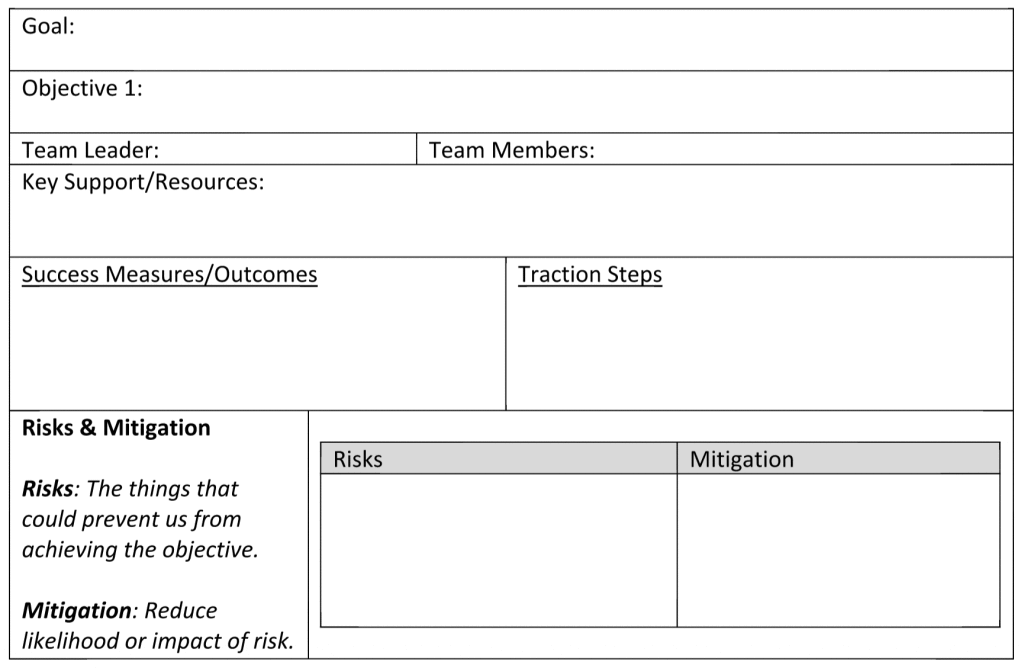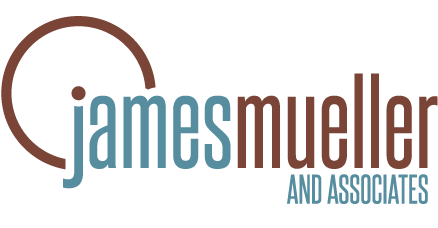Strategic Plan Template & Download
It is the cadence of accountability that actually converts a plan into action.
Since we’ve had requests for a written strategic plan template, here it is. However you craft a plan, it should not be too complex or overblown with lots of narrative. Be concise. The written plan should be a tool for focus and action. It is also a tool for communication. An effective written plan tells your stakeholders where you are headed, how you will get there, and who is responsible.
Some organizations choose to write a document that includes the statement of organizational strategy, strategic imperatives, and long-term goals, and then use this template to write a succession of annual plans. Adapt to your culture. Allow for flexibility. Use this template as a guide. Allow this to be a working document that can evolve. As Drucker wrote, “When the environment changes the rules change.” If you have a tech savvy, engaged team you can find web-based tools that allow dynamic interface with your plan and the ability to track progress.
Written plans should be crafted by those accountable for implementation. Every team member responsible for goals should complete the template. For the sake of clarity, we recommend one template page per objective.
 A goal is a “what,” a specific, quantifiable outcome that, when attained, contributes to achievement of the strategic imperatives and improves the performance of the organization. Objectives are components of goals that define “how” the goal will be achieved. Each goal may have a number of objectives—though we advise that fewer, well-designed objectives are better. The team leader is the person who owns achievement of the goal (and all of its components) and is held accountable for its achievement. Team members are those employees whose cooperation and/or contribution are essential to achieving the goal. (Distributed leadership/team collaboration is becoming more prominent in organizations, particularly with the increasing number of Millennials in the workplace.) Team members are also held accountable for their responsibilities. Key support and resources refer to those items (whether budget, staffing, technology, etc.) that are necessary for the team to succeed. Success measures and outcomes indicate achievement of the objective. Traction steps are the key activities that the team agrees will produce the necessary outcomes. Risks as described earlier are often self-evident. They are the things that keep us awake at night. Key risks should be captured in the plan document, as well as mitigation strategies, i.e. what the organization will do to lessen the likelihood and/or mitigate the consequence.
A goal is a “what,” a specific, quantifiable outcome that, when attained, contributes to achievement of the strategic imperatives and improves the performance of the organization. Objectives are components of goals that define “how” the goal will be achieved. Each goal may have a number of objectives—though we advise that fewer, well-designed objectives are better. The team leader is the person who owns achievement of the goal (and all of its components) and is held accountable for its achievement. Team members are those employees whose cooperation and/or contribution are essential to achieving the goal. (Distributed leadership/team collaboration is becoming more prominent in organizations, particularly with the increasing number of Millennials in the workplace.) Team members are also held accountable for their responsibilities. Key support and resources refer to those items (whether budget, staffing, technology, etc.) that are necessary for the team to succeed. Success measures and outcomes indicate achievement of the objective. Traction steps are the key activities that the team agrees will produce the necessary outcomes. Risks as described earlier are often self-evident. They are the things that keep us awake at night. Key risks should be captured in the plan document, as well as mitigation strategies, i.e. what the organization will do to lessen the likelihood and/or mitigate the consequence.
Let me provide an example—granted, it’s a bit simple, but provides a sense of how to use the template. If the goal is to increase the number of members by 25%, one of the objectives might be, “redesign outreach to include six new acquisition packages integrating social media, email, and direct mail.” (Other objectives could include redesign member benefits to emphasize stated preferences or reduce recidivism by proactive engagement strategies.)

Drucker wrote, “When the environment changes the rules change.” Allow this template to be a working document that can evolve. Use it as a guide.
The team leader is the person responsible for increasing membership and the team members are all those people responsible for design, production, distribution, tracking, and reporting. Key support or resources might include such things as: increase budget from x to y, part time administrator to input data, track results, and generate report, new software application, etc. Success measures and outcomes might be: Increase # new members by “x%” in first six months, by “y%” by year one, etc.; first time engagement with prospective members through social media; “x” attendance at “y” outreach events.
Traction steps can include: identify and secure high-value contact lists by x date; develop and deliver 3 test mailings using controls and variables; fine tune distribution mix at six month interval etc.; develop and implement 3 social media events/experiences; track key words in online inquiries and place targeted ads; etc. Here is an example of a risk and mitigation. The risk: poor performance on all recruitment test packages. The mitigations: (1) lessen the likelihood – careful selection of audience, clear understanding and articulation of member benefits, understand best practices; (2) mitigate consequences – conduct in-depth analysis of package attributes, audience recipients; review alignment of member benefits; conduct survey; retool.
As I wrote in the opening of part one of this post, the purpose of strategic planning is to develop sound strategy, to provide an organization with a well-informed, reliable sense of direction that also brings order and organization to the activities it undertakes. The purpose of the written plan is to bring clarity to expectation and accountability. It is the cadence of accountability that actually converts a plan into action. And a good written plan provides the basis.
In a future post I will discuss effective ways to convert plans into action.

